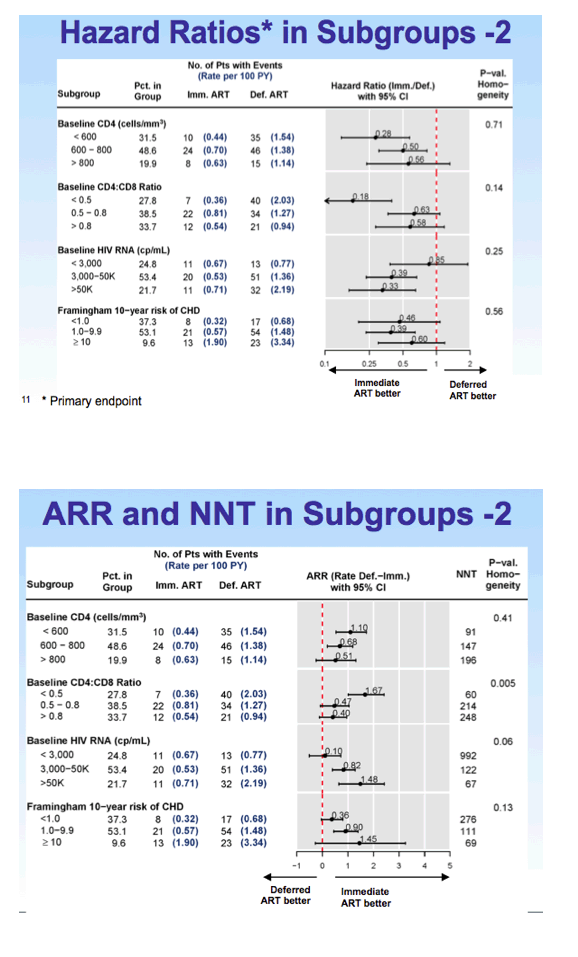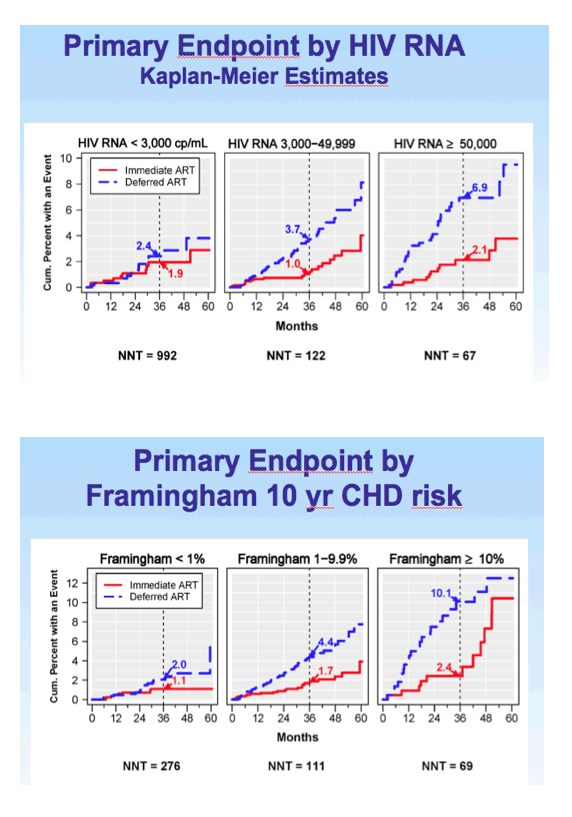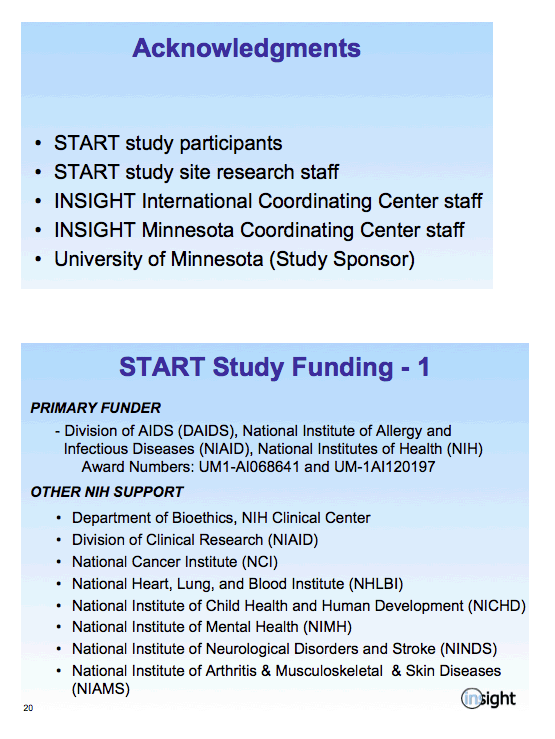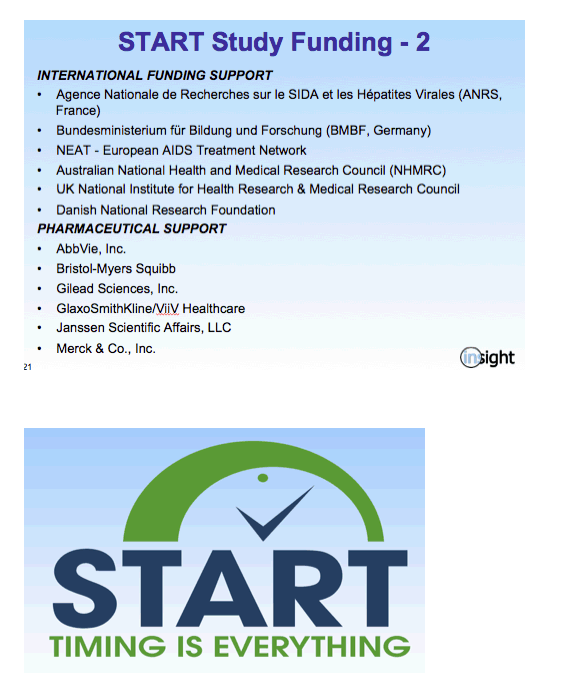 |
 |
 |
| |
Which START Participants Got the Most Benefit From Early ART?
|
| |
| |
21st International AIDS Conference (AIDS 2016), July 18-22, 2016, Durban, South Africa
Mark Mascolini
START trial participants older than 50, those with a viral load above 50,000 copies, those with a CD4:CD8 ratio under 0.5, and those with a 10-year Framingham cardiovascular risk score above 10% enjoyed the greatest absolute reduction in risk of AIDS, a non-AIDS illness, or death in this landmark trial [1]. Immediate antiretroviral therapy (ART) proved superior to deferred ART in every subgroup analyzed.
START enrolled 4685 asymptomatic people with a CD4 count above 500 and randomized them to immediate ART or to defer ART until their CD4 count fell to 350 or AIDS developed [2]. Through 3 years of follow-up, immediate ART lowered the risk of AIDS, a serious non-AIDS illness, or death by 57% (P < 0.001).
The new analysis aimed to determine whether certain subgroups derived more benefit from immediate ART than others. START participants had a median age of 36 years, 27% were women, 55% men who have sex with men, 44.5% white, and 30% black. Median pretreatment CD4 count stood at 651 and median viral load at 12,759 copies. Median 10-year Framingham risk stood at 1.9% in this young study group, meaning about 2% of study participants risked cardiovascular disease in the next 10 years.
For each subgroup, START investigators estimated primary event rates per 100 person-years, hazard ratio (HR) for primary events, absolute risk reduction with immediate ART (rate in deferred group minus rate in the immediate group), and the number needed to treat immediately for 1 year to prevent 1 event compared with deferred ART.
Overall the researchers counted 42 primary events (AIDS, non-AIDS illness, or death) in the immediate arm and 96 in the deferred arm. Absolute risk reduction (ARR) with immediate ART came to 22% (ARR 0.78, 95% confidence interval 0.46 to 1.12). Number needed to treat for 1 year to prevent 1 event was 128 in this overall analysis.
In subgroup analyses hazard ratios for a primary event always gave the advantage to immediate ART, and that advantage was almost always statistically significant: age younger than 30 (HR 0.42), age 30 to 49 (HR 0.43), age 50 or older (HR 0.45), male sex (HR 0.47), female sex (HR 0.31), black race (HR 0.57, not significant), white race (HR 0.40), high-income region (HR 0.39), low/medium-income region (HR 0.48).
Similarly, absolute risk reduction analyses always favored immediate ART: age younger than 30 (ARR 0.49), age 30 to 49 (ARR 0.66), age 50 or older (ARR 2.24), male sex (ARR 0.74), female sex (ARR 0.93), black race (ARR 0.70), white race (ARR 0.92), high-income region (ARR 0.86), low/medium-income region (ARR 0.69). Number needed to treat for 1 year to prevent 1 event ranged from 116 to 206 across these subgroups, except for people older than 50, for whom the number needed to treat was only 45.
The researchers also calculated hazard ratios, absolute risk reduction, and number needed to treat for subgroups by baseline CD4 count (<600, 600 to 800, >800), baseline CD4:CD8 ratio (<0.5, 0.5 to 0.8, >0.8), baseline viral load (<3000, 3000 to 50,000, >50,000), and Framingham 10-year risk score (<1.0%, 1.0% to 9.9%, >/= 10%). In these analyses the most striking hazard ratios favoring immediate treatment were baseline CD4:CD8 ratio <0.5 (HR 0.18) and baseline viral load >50,000 (HR 0.33). For those two subgroups and for Framingham risk score >/= 10, absolute risk reduction and number needed to treat were 1.67 and 60 for CD4:CD8 ratio <0.5, 1.48 and 67 for viral load >50,000, and 1.45 and 69 for Framingham score >/= 10.
Kaplan-Meier estimates of reaching a primary endpoint confirmed that those last three groups, plus people older than 50, had the most to gain from immediate ART: CD4:CD8 ratio <0.5, K-M estimate 6.3 versus 0.5 for immediate versus deferred ART; viral load >/= 50,000, K-M estimate 6.9 versus 2.1 for immediate versus deferred ART; Framingham score >/= 10, K-M estimate 10.1 versus 2.4 for immediate versus deferred ART; age over 50, K-M estimate 11.7 versus 2.9 for immediate versus deferred ART.
The START team suggested that these four groups--people older than 50, those with a baseline viral load above 50,000 copies, those with a CD4:CD8 ratio below 0.5, and those with a 10-year Framingham risk score above 10%--might be prioritized for immediate access to ART.
References
1. Molina JM, Grund B, Gordin F, et al. Who benefited most from immediate treatment in START? A subgroup analysis. 21st International AIDS Conference (AIDS 2016). July 18-22, 2016. Durban, South Africa. Abstract THAB0201.
2. INSIGHT START Study Group, Lundgren JD, Babiker AG, Gordin F, et al. Initiation of antiretroviral therapy in early asymptomatic HIV infection. N Engl J Med. 2015;373:795-807.
http://www.nejm.org/doi/full/10.1056/NEJMoa1506816
-------------------
nice analysis, Jules
Who Benefited Most From Immediate Treatment in START - A Subgroup Analysis
Reported by Jules Levin
21st International AIDS Conference,
July 18-22, 2016, Durban, South Africa
JM Molina, B Grund, F Gordin, I Williams, M Schechter, M Losso, M Law, E Ekong, N Mwelase, A Skoutelis, MJ Wiselka, L Vendekerckhove,
T Benfield, D Munroe, JD Lundgren and JD Neaton
for the INSIGHT START Study Group











|
| |
|
 |
 |
|
|